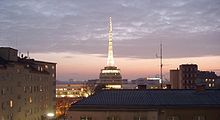Vienna Exhibition Center

The Wiener Messe is the most important trade fair location in Austria and an essential economic factor for Vienna . It is managed by Wiener Messebesitz GmbH , 95 percent of which is owned by the city through Wien Holding . The Vienna Chamber of Commerce holds the remaining five percent .
General
Messe Wien has an area of 15 hectares , 55,000 m² of exhibition space, an attached congress center and an office tower with an idiosyncratic, pointed steel construction. It is considered the landmark of the exhibition center. The fair, which is relatively small in international comparison, handles around 20 events a year, mainly trade fairs that are open to the public.
The newly designed Messe Wien opened in 2004 and has had an underground connection ( U2 ) since 2008 . The site is located in the Leopoldstadt district on Exhibition Street , right next to the Prater .
history
After only four months of planning, the first Viennese fair opened on September 11, 1921 with the aim of leading Austria out of the economic isolation after the First World War . The exhibitions (not accessible to the public) were spread over several locations in Vienna and had Messe Frankfurt, which had been relaunched three years earlier, as a model . The largest area comprised parts of the area of the Vienna World Exhibition of 1873 in the Prater. The central building was the rotunda designed by John Scott Russell on the occasion of the world exhibition (which had always been unsuitable for a trade fair and which fell into ruin in 1921) including its open spaces. Other venues were the court stables , the collegiate barracks (paper fair) and the commercial academy (medical and surgical instruments).
In the following years the rotunda was used for numerous exhibitions and events. From 1921 the Vienna Fair ( spring fair , autumn fair ) was held twice a year . As early as 1923, Wiener Messe AG received the irrevocable state award , which allows it to carry the national coat of arms in business dealings over the long term .
After the fire in the rotunda in 1937 and the "annexation" to the National Socialist Third Reich , the Vienna trade fair location lost more and more importance and the Vienna trade fair was finally discontinued in 1942. During the Second World War , the other buildings and the surrounding exhibition grounds were largely destroyed.
Post-war to the present
The first “export sample show”, organized by the city's own trade fair company, took place in 1946 on the largely destroyed site, and the autumn trade fair opened in the same year on the area that was already partially renovated. In 1950 the reconstruction was completed. For decades now, the spring and autumn fairs have been the meeting point for hundreds of thousands of visitors. Companies erected lavishly designed pavilions here; the one designed by Oswald Haerdtl in 1953 for Felten & Guilleaume is z. B. to this day to be found in electronic architecture documentation.
At the end of the 20th century, the classic exhibition grounds were divided, the old buildings were removed: a new exhibition and congress center ( Messe Wien Exhibition & Congress Center ) was opened on the northern part in 2004 . The WU campus , the architecturally remarkable current headquarters of the Vienna University of Economics and Business Administration, was built on the southern part by 2013 . The new Sigmund Freud University was opened in 2015 on the southwestern part of the former exhibition grounds between Freudplatz and Welthandelsplatz .
architecture
The cylindrical trade fair tower with its stepped attic storeys has a construction class height of 26 m and, unlike the other trade fair components, is in operation all year round. The trade fair steel tower set up on the recessed top floor forms the new trade fair landmark with its highly visible and illuminated spire (total height 96 m). This component has a basement in its entirety.
Data at a glance
- Tower height: 96 m
- Exhibition space: 55,000 m²
- Exhibition halls: 4
- Area size: 15 ha
- Capacity: 25,000 people
- Investment volume: 192 million euros
Architects
- Gustav Peichl
- Rudolf F. Weber
- Katharina Froch
- Christoph Lechner
- Paul Katzberger
- Gerhard Moßburger
- Norbert Erlach
Trade fairs that take place in the Vienna Exhibition Center
- Intertool - International trade fair for industry
- Vienna Autoshow
- VIECC Vienna Comic Con - Comic & Entertainment Expo
- Lust for Life - Seniors Fair
- Profit fair - fair around the topic of investments
- Model building fair - fair for model building , games, hobby and handicrafts
- Holiday fair Vienna
- Photo + Adventure - trade fair for travel, photography and outdoor
- Bauen & Energie Wien - trade fair for healthy building, renovation, financing and energy saving
- Living & interior fair - fair for furniture, design, furnishing and garden
- Buch Wien - International Book Fair and Reading Festival
- Vienna Comic Con - since 2015
Other uses
There are always concerts in the Vienna Exhibition Center. The bands Böhse Onkelz , Tic Tac Toe and The Fugees performed here .
Individual evidence
- ↑ Robert Orley : The Vienna International Fair in the fall of 1921. In: The architect , born in 1921, pp 49-61. (Online at ANNO ). .
- ↑ The pavilion in the Europeana documentation, as of 2015
Web links
- Margot Fürstenwarther: The III. Vienna International Fair. In: Die Moderne Welt , year 1922, issue 5 (October), year IV, p. 7 f. (Online at ANNO ). .
- Homepage of the trade fair organizer Reed Exhibitions
- Homepage of the trade fair company MBG
- Messe Wien as an interactive 360 ° × 180 ° panorama photo (requires Adobe Flash )
- Profit fair
- Model making fair
- Holiday fair Vienna
- CLASSIC CAR SHOW VIENNA
- Jaspowa & fishing
- BAUEN & ENERGIE VIENNA
- Living & interior
- VIENNAFAIR
Coordinates: 48 ° 12 ′ 59 ″ N , 16 ° 24 ′ 32 ″ E







